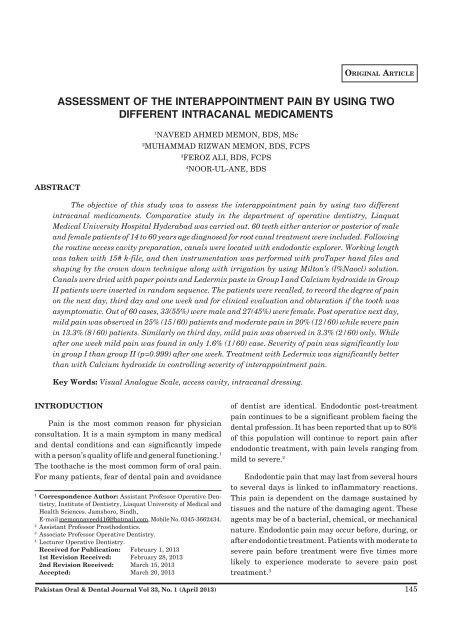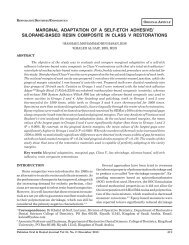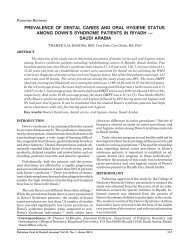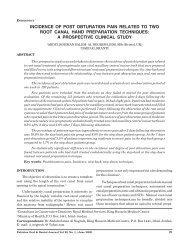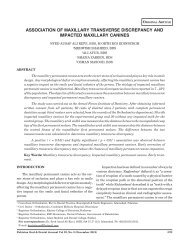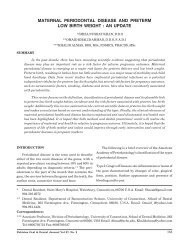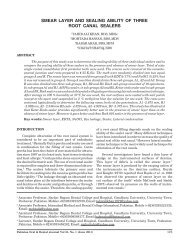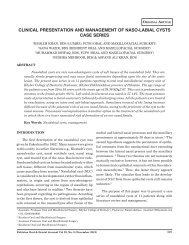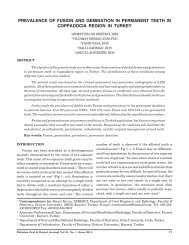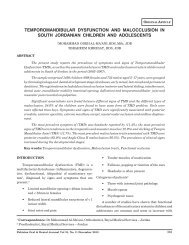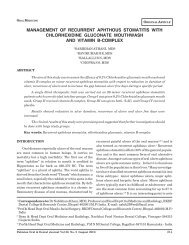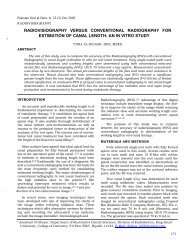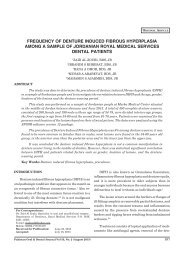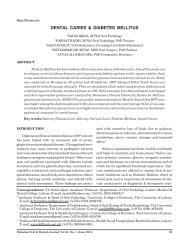assessment of the interappointment pain by using two different ...
assessment of the interappointment pain by using two different ...
assessment of the interappointment pain by using two different ...
Create successful ePaper yourself
Turn your PDF publications into a flip-book with our unique Google optimized e-Paper software.
Assessment <strong>of</strong> <strong>interappointment</strong> <strong>pain</strong><br />
ORIGINAL ARTICLE<br />
ASSESSMENT OF THE INTERAPPOINTMENT PAIN BY USING TWO<br />
DIFFERENT INTRACANAL MEDICAMENTS<br />
1<br />
NAVEED AHMED MEMON, BDS, MSc<br />
2<br />
MUHAMMAD RIZWAN MEMON, BDS, FCPS<br />
3<br />
FEROZ ALI, BDS, FCPS<br />
4<br />
NOOR-UL-ANE, BDS<br />
ABSTRACT<br />
The objective <strong>of</strong> this study was to assess <strong>the</strong> <strong>interappointment</strong> <strong>pain</strong> <strong>by</strong> <strong>using</strong> <strong>two</strong> <strong>different</strong><br />
intracanal medicaments. Comparative study in <strong>the</strong> department <strong>of</strong> operative dentistry, Liaquat<br />
Medical University Hospital Hyderabad was carried out. 60 teeth ei<strong>the</strong>r anterior or posterior <strong>of</strong> male<br />
and female patients <strong>of</strong> 14 to 60 years age diagnosed for root canal treatment were included. Following<br />
<strong>the</strong> routine access cavity preparation, canals were located with endodontic explorer. Working length<br />
was taken with 15# k-file, and <strong>the</strong>n instrumentation was performed with proTaper hand files and<br />
shaping <strong>by</strong> <strong>the</strong> crown down technique along with irrigation <strong>by</strong> <strong>using</strong> Milton’s (l%Naocl) solution.<br />
Canals were dried with paper points and Ledermix paste in Group I and Calcium hydroxide in Group<br />
II patients were inserted in random sequence. The patients were recalled, to record <strong>the</strong> degree <strong>of</strong> <strong>pain</strong><br />
on <strong>the</strong> next day, third day and one week and for clinical evaluation and obturation if <strong>the</strong> tooth was<br />
asymptomatic. Out <strong>of</strong> 60 cases, 33(55%) were male and 27(45%) were female. Post operative next day,<br />
mild <strong>pain</strong> was observed in 25% (15/60) patients and moderate <strong>pain</strong> in 20% (12/60) while severe <strong>pain</strong><br />
in 13.3% (8/60) patients. Similarly on third day, mild <strong>pain</strong> was observed in 3.3% (2/60) only. While<br />
after one week mild <strong>pain</strong> was found in only 1.6% (1/60) case. Severity <strong>of</strong> <strong>pain</strong> was significantly low<br />
in group I than group II (p=0.999) after one week. Treatment with Ledermix was significantly better<br />
than with Calcium hydroxide in controlling severity <strong>of</strong> <strong>interappointment</strong> <strong>pain</strong>.<br />
Key Words: Visual Analogue Scale, access cavity, intracanal dressing.<br />
INTRODUCTION<br />
Pain is <strong>the</strong> most common reason for physician<br />
consultation. It is a main symptom in many medical<br />
and dental conditions and can significantly impede<br />
with a person’s quality <strong>of</strong> life and general functioning. 1<br />
The toothache is <strong>the</strong> most common form <strong>of</strong> oral <strong>pain</strong>.<br />
For many patients, fear <strong>of</strong> dental <strong>pain</strong> and avoidance<br />
1<br />
Correspondence Author: Assistant Pr<strong>of</strong>essor Operative Dentistry,<br />
Institute <strong>of</strong> Dentistry, Liaquat University <strong>of</strong> Medical and<br />
Health Sciences. Jamshoro, Sindh,<br />
E-mail memonnaveed416@hotmail.com, Mobile No. 0345-3662434.<br />
2<br />
Assistant Pr<strong>of</strong>essor Prosthodontics.<br />
3<br />
Associate Pr<strong>of</strong>essor Operative Dentistry.<br />
4<br />
Lecturer Operative Dentistry.<br />
Received for Publication: February 1, 2013<br />
1st Revision Received: February 28, 2013<br />
2nd Revision Received: March 15, 2013<br />
Accepted: March 20, 2013<br />
Pakistan Oral & Dental Journal Vol 33, No. 1 (April 2013)<br />
<strong>of</strong> dentist are identical. Endodontic post-treatment<br />
<strong>pain</strong> continues to be a significant problem facing <strong>the</strong><br />
dental pr<strong>of</strong>ession. It has been reported that up to 80%<br />
<strong>of</strong> this population will continue to report <strong>pain</strong> after<br />
endodontic treatment, with <strong>pain</strong> levels ranging from<br />
mild to severe. 2<br />
Endodontic <strong>pain</strong> that may last from several hours<br />
to several days is linked to inflammatory reactions.<br />
This <strong>pain</strong> is dependent on <strong>the</strong> damage sustained <strong>by</strong><br />
tissues and <strong>the</strong> nature <strong>of</strong> <strong>the</strong> damaging agent. These<br />
agents may be <strong>of</strong> a bacterial, chemical, or mechanical<br />
nature. Endodontic <strong>pain</strong> may occur before, during, or<br />
after endodontic treatment. Patients with moderate to<br />
severe <strong>pain</strong> before treatment were five times more<br />
likely to experience moderate to severe <strong>pain</strong> post<br />
treatment. 3<br />
145
Assessment <strong>of</strong> <strong>interappointment</strong> <strong>pain</strong><br />
Endodontic treatment can be followed <strong>by</strong> short or<br />
long term complications. Some <strong>of</strong> <strong>the</strong> problems <strong>of</strong> root<br />
canal treatment are post obturation <strong>pain</strong>,<br />
<strong>interappointment</strong> <strong>pain</strong> and swelling. Pain and swelling<br />
is <strong>of</strong>ten sign <strong>of</strong> an <strong>of</strong>fending tooth. Endodontic<br />
treatment aims to reverse <strong>the</strong> disease process and<br />
<strong>the</strong>refore eliminate <strong>the</strong> associated signs and symptoms.<br />
4<br />
Information on <strong>the</strong> causes and <strong>the</strong> mechanisms<br />
behind <strong>interappointment</strong> <strong>pain</strong> in endodontics is important<br />
for <strong>the</strong> clinician to correctly prevent or manage<br />
this undesirable condition. The causative factors <strong>of</strong><br />
<strong>interappointment</strong> <strong>pain</strong> cover mechanical, chemical,<br />
and/or microbial injury to <strong>the</strong> periradicular tissues,<br />
which are induced or aggravated during root canal<br />
treatment. When an <strong>interappointment</strong> emergency occurs,<br />
appropriate diagnosis and active treatment are<br />
required for <strong>the</strong> clinician to succeed in solving <strong>the</strong><br />
problem. Certain factors have been recommended to<br />
significantly influence <strong>the</strong> development <strong>of</strong><br />
<strong>interappointment</strong> <strong>pain</strong> including age, gender, tooth<br />
type, pulpal status, presence <strong>of</strong> preoperative <strong>pain</strong>,<br />
allergies, and presence <strong>of</strong> sinus tract. 5<br />
In root canal disinfection, complete chemomechanical<br />
preparation may be considered an essential step.<br />
Though, total elimination <strong>of</strong> bacteria is difficult to<br />
achieve, intracanal medicaments may assist to eliminate<br />
surviving bacteria. 6 Intracanal medication has<br />
been widely used in efforts to kill any bacteria remaining<br />
after instrumentation and irrigation. Several <strong>different</strong><br />
medicaments have been used over <strong>the</strong> years.<br />
Common were calcium hydroxide, eugenol, iodine potassium<br />
iodide, glutaraldehyde, formocreosol, camphorated<br />
parachlorophenol, metacresylacetate,<br />
beechwood creosote, and a range <strong>of</strong> antibiotic combinations.<br />
7<br />
Intracanal medicaments may prevent <strong>the</strong> penetration<br />
<strong>of</strong> bacteria from saliva in <strong>the</strong> root canal basically<br />
in <strong>two</strong> ways. First, medicaments possessing antibacterial<br />
properties may act as a chemical barrier<br />
against leakage <strong>by</strong> killing bacteria, thus preventing<br />
<strong>the</strong>ir ingress into <strong>the</strong> root canal. Secondly, medicaments<br />
that fill <strong>the</strong> entire length <strong>of</strong> <strong>the</strong> root canal act as<br />
a physical barrier against bacterial penetration. 8<br />
Calcium hydroxide if left in <strong>the</strong> canal for four<br />
weeks, it will be more effective medicament than<br />
Pakistan Oral & Dental Journal Vol 33, No. 1 (April 2013)<br />
ei<strong>the</strong>r CMCP or camphorated phenol reported <strong>by</strong><br />
Byström et al 8 . Calcium hydroxide was able to render<br />
97% <strong>of</strong> <strong>the</strong>ir canals culture-negative, while o<strong>the</strong>r medicaments<br />
achieved this in only <strong>two</strong>-thirds <strong>of</strong> <strong>the</strong><br />
treated canals 8 .<br />
Ledermix is a corticosteroid antibiotic paste or<br />
cement. Ledermix paste is an ideal medicament to be<br />
used as an initial dressing predominantly if <strong>the</strong> patient<br />
presents with endodontic symptoms. Though <strong>the</strong><br />
antibacterial spectrum <strong>of</strong> Ledermix paste, against <strong>the</strong><br />
most commonly found endodontic bacteria has been<br />
reported. 9<br />
The results <strong>of</strong> this study may <strong>the</strong>refore be helpful<br />
for <strong>the</strong> practitioners in performing <strong>the</strong> Root Canal<br />
Treatment with a better approach, so patients experience<br />
a smaller amount <strong>of</strong> <strong>pain</strong> during <strong>interappointment</strong><br />
visits.<br />
METHODOLOGY<br />
Comparative study was carried out at <strong>the</strong> department<br />
<strong>of</strong> Operative Dentistry, Liaquat Medical University<br />
Hospital Hyderabad from 1 st may to 30 th November<br />
2010. Sixty patients were treated, which were<br />
divided into <strong>two</strong> groups; in Group one: 30 were treated<br />
with ledermix paste and in Group <strong>two</strong>: 30 were treated<br />
with calcium hydroxide. Randomized sampling technique<br />
was used. All anterior and posterior teeth with<br />
periapcial peridontities, with or without periapical<br />
radiolucency and with pulp necrosis <strong>of</strong> ei<strong>the</strong>r gender <strong>of</strong><br />
14 to 60 year <strong>of</strong> age were included in <strong>the</strong> study. Teeth<br />
with incomplete root formation and teeth with severe<br />
periodontal problem and patients suffering from systemic<br />
problems e.g. diabetes and autoimmune disease<br />
etc were excluded from <strong>the</strong> study.<br />
Patients were selected <strong>by</strong> odd numbers and randomly<br />
divided into <strong>two</strong> groups and informed consent<br />
for <strong>the</strong> procedure was obtained. Complete<br />
demographical data were recorded on pr<strong>of</strong>orma . Before<br />
start <strong>of</strong> treatment, preoperative <strong>pain</strong> was recorded<br />
on pr<strong>of</strong>orma <strong>by</strong> <strong>using</strong> Visual Analogue Scale<br />
(VAS). Following <strong>the</strong> routine access cavity preparation<br />
and location <strong>of</strong> canals were attempted <strong>by</strong> exploring<br />
method with endodontic explorer. Working length was<br />
taken with No.15 K-files and <strong>the</strong>n instrumentation<br />
was performed with pro Taper hand files and shaping<br />
<strong>by</strong> <strong>the</strong> crown down method along with irrigation <strong>using</strong><br />
146
Assessment <strong>of</strong> <strong>interappointment</strong> <strong>pain</strong><br />
Milton’s (l%Naocl) solution. Canals were dried with<br />
paper points and one <strong>of</strong> <strong>the</strong> <strong>two</strong> medicaments was<br />
inserted into canal in random sequence. Group One:<br />
Ledermix paste (lederle pharmaceuticals) and Group<br />
<strong>two</strong>: Calcium hydroxide (calcipulp, septodent France).<br />
The patients were recalled to record <strong>the</strong> degree <strong>of</strong><br />
<strong>pain</strong> next day, third day and after one week <strong>of</strong> <strong>the</strong><br />
intracanal dressing and were called for clinical evaluation<br />
and obturation if symptom less. Data were analyzed<br />
in statistical s<strong>of</strong>tware SPSS-16. Frequency and<br />
percentage were computed <strong>of</strong> categorical variables<br />
like gender, and severity <strong>of</strong> <strong>pain</strong> while mean and<br />
standard deviation were estimated for quantitative<br />
variables like age. Chi-square test was applied to<br />
compare proportion difference between groups in severity<br />
<strong>of</strong> <strong>pain</strong> with respect to follow-up. Independent<br />
sample t test was applied to compare mean age between<br />
groups. P
Assessment <strong>of</strong> <strong>interappointment</strong> <strong>pain</strong><br />
Fig. 3: Gender Distribution with Respect to Groups<br />
Chi-Square = 1.900 df= 3 p=0.59<br />
Fig. 4: Comparison <strong>of</strong> <strong>interappointment</strong> Pain<br />
between Groups after postoperative next day<br />
Fisher Exact test applied; df= 2 p=0.999<br />
Fig. 6: Comparison <strong>of</strong> <strong>interappointment</strong> Pain between<br />
Groups after one week<br />
not significant difference 3 rd day and after one week<br />
while in group II difference <strong>of</strong> <strong>pain</strong> was also not<br />
significant among follow-up.<br />
Post operative next day, mild <strong>pain</strong> was 25% (15/60)<br />
patients and moderate <strong>pain</strong> was observed in 20% (12/<br />
60) while severe <strong>pain</strong> was noted in 13.3% (8/60) patients.<br />
Comparison <strong>of</strong> inter appointment <strong>pain</strong> between<br />
groups after postoperative at next day were assessed<br />
but significant difference was not observed (0.59) as<br />
presented in figure 4. Similarly at third day, mild <strong>pain</strong><br />
was observed in 3.3% (2/60) but significant difference<br />
was also not observed between groups (0.999) as shown<br />
in figure 5. While after one week mild <strong>pain</strong> was found<br />
in only 1.6% (1/60) case. Severity <strong>of</strong> <strong>pain</strong> was significantly<br />
low in group I than in group II (0.999) after one<br />
week as presented in figure 6.<br />
DISCUSSION<br />
Chi-Square = 0.091 df= 2 p=0.999<br />
Fig. 5: Comparison <strong>of</strong> Interappointment Pain<br />
between Groups Third Day<br />
Pakistan Oral & Dental Journal Vol 33, No. 1 (April 2013)<br />
The purpose <strong>of</strong> intracanal medicaments is an adjuvant<br />
<strong>the</strong>rapy to resolve <strong>the</strong> infection. Ledermix (triamcinolone<br />
and dimethylchlorotetracycline in a water<br />
soluble cream) is used for pulp capping, exposures, and<br />
as an intracanal medicament in cases with pericementitis<br />
reported <strong>by</strong> Ehrmann 10 . He concluded that<br />
ledermix stopped <strong>the</strong> <strong>pain</strong> associated with pericementitis.<br />
Langeland et al used ledermix as an intracanal<br />
medicament in cases <strong>of</strong> continued postoperative <strong>pain</strong><br />
after pulpal extirpation or canal instrumentation. They<br />
reported <strong>pain</strong> relief in <strong>the</strong>se cases within minutes to a<br />
few hours after <strong>the</strong> placement <strong>of</strong> ledermix. 10 Numerous<br />
past studies show diminution or absence <strong>of</strong><br />
<strong>interappointment</strong> <strong>pain</strong> when ledermix was used after<br />
debridement. 11<br />
148
Assessment <strong>of</strong> <strong>interappointment</strong> <strong>pain</strong><br />
Ehrmann et al 10 explore <strong>the</strong> relationship <strong>of</strong> postoperative<br />
<strong>pain</strong> associated with three <strong>different</strong> treatment<br />
regimes for infected teeth with acute apical periodontitis<br />
after complete biomechanical debridement <strong>of</strong> <strong>the</strong><br />
root canal system in patients presenting for emergency<br />
relief <strong>of</strong> <strong>pain</strong>. They informed that <strong>the</strong> patients<br />
with teeth dressed with ledermix paste had less <strong>pain</strong><br />
than that experienced <strong>by</strong> patients who had teeth<br />
dressed with calcium hydroxide or no dressing at all.<br />
Calcium hydroxide has a great value in endodontics<br />
and is used for several clinical conditions. It has a<br />
limited antibacterial spectrum that does not affect all<br />
members <strong>of</strong> <strong>the</strong> endodontic microbiota. Additionally,<br />
physicochemical properties <strong>of</strong> this substance may limit<br />
its effectiveness in disinfecting <strong>the</strong> entire root canal<br />
system after a short-term use. 12 However, <strong>the</strong> antibacterial<br />
activity <strong>of</strong> calcium hydroxide is still controversial<br />
and it is not clear whe<strong>the</strong>r <strong>the</strong> benefits <strong>of</strong> this<br />
substance are based solely upon superior antibacterial<br />
activity. 13<br />
There are <strong>two</strong> possible reasons for <strong>the</strong> failed inhibition<br />
<strong>of</strong> bacteria with calcium hydroxide. One rapid<br />
absorption <strong>of</strong> calcium hydroxide leading to a pH fall to<br />
neutral levels and Two, bacteria that are pocketed<br />
from <strong>the</strong> action <strong>of</strong> <strong>the</strong> chemical <strong>by</strong> high caliber <strong>of</strong> <strong>the</strong>ir<br />
survival and/ or growth within dentinal tubules or<br />
<strong>the</strong>ir ramification and microleakage <strong>of</strong> temporary filling<br />
materials between appointments. 14<br />
The choice <strong>of</strong> which intracanal medicament to use<br />
during endodontic treatment is dependent on having<br />
an accurate diagnosis <strong>of</strong> <strong>the</strong> condition being treated. If<br />
<strong>the</strong> primary aim is to control inflammation, <strong>the</strong>n a<br />
corticosteroid- antibiotic mixture is indicated. The<br />
current study indicates that calcium hydroxide may<br />
not be <strong>the</strong> most ideal medicament for all cases with<br />
infected root canal systems with or without apical<br />
periodontitis and in previously root filled teeth. 15<br />
The relationship <strong>of</strong> intracanal medicaments to socalled<br />
endodontic flare-ups: Formocresol, ledermix and<br />
calcium hydroxide were placed in strict sequence irrespective<br />
<strong>of</strong> <strong>the</strong> presence or absence <strong>of</strong> symptoms and<br />
radiographic signs <strong>of</strong> apical periodontitis. Trope evaluated<br />
and he found no significant difference in <strong>the</strong> flareup<br />
rate amongst <strong>the</strong>se three intracanal medicaments. 16<br />
Mechanical, chemical or microbial insult during<br />
root canal preparation and may clarify its effect on<br />
Pakistan Oral & Dental Journal Vol 33, No. 1 (April 2013)<br />
prevalence <strong>of</strong> post preparation <strong>pain</strong>. O<strong>the</strong>r factors<br />
such as age, gender, history <strong>of</strong> allergies, presence <strong>of</strong><br />
sinus tract, size <strong>of</strong> lesion and history <strong>of</strong> root canal<br />
treatment were found to have no significant influence<br />
on post preparation <strong>pain</strong>. 7<br />
Various authors have reported <strong>the</strong> incidence <strong>of</strong><br />
post treatment endodontic <strong>pain</strong>. The information <strong>of</strong><br />
incidence <strong>of</strong> <strong>pain</strong> was disconcertingly <strong>different</strong> among<br />
clinical investigators. O’Keefe 17 found that 16% <strong>of</strong><br />
patients had moderate to severe post treatment <strong>pain</strong>.<br />
Clem 18 found that 25% incidence <strong>of</strong> post treatment<br />
<strong>pain</strong> after endodontic treatment <strong>of</strong> 318 teeth. Seltzer<br />
et al 19 reported a 40% incidence <strong>of</strong> post treatment <strong>pain</strong><br />
in a study <strong>of</strong> 698 patients. In this study, <strong>the</strong> incidence<br />
<strong>of</strong> post treatment <strong>pain</strong> was 48.5%. The variability <strong>of</strong><br />
human <strong>pain</strong> response could, in part, be a result <strong>of</strong><br />
social, cultural, and psychological factors.<br />
The most prominent observation in <strong>the</strong> present<br />
study was <strong>the</strong> frequency with which <strong>the</strong><br />
<strong>interappointment</strong> <strong>pain</strong> associated with endodontic<br />
<strong>the</strong>rapy disappeared. The corticosteroid-antibiotic<br />
cream was placed in <strong>the</strong> root canal, and <strong>pain</strong> subsided<br />
within an hour in <strong>the</strong> majority <strong>of</strong> patients, supporting<br />
<strong>the</strong> results <strong>of</strong> Schneider 20 . Who reported that when <strong>the</strong><br />
steroid antibiotic cream was placed in <strong>the</strong> canal, <strong>pain</strong><br />
subsided before <strong>the</strong> patient left <strong>the</strong> <strong>of</strong>fice. No incidence<br />
<strong>of</strong> postoperative infection or swelling was recorded<br />
with <strong>the</strong> use <strong>of</strong> <strong>the</strong> corticosteroid antibiotic medication.<br />
There was no <strong>pain</strong> or sensitivity after <strong>the</strong> treatment,<br />
and no side effects were recorded after <strong>the</strong> use <strong>of</strong><br />
<strong>the</strong> drug. The possibility <strong>of</strong> systemic side effects is<br />
remote as <strong>the</strong> constituents absorbed from <strong>the</strong> site over<br />
a relatively short duration are minute.<br />
These findings are highly hopeful and equivalent<br />
with <strong>the</strong> findings reported in previous studies <strong>of</strong> such<br />
kind 10 . The decrease in <strong>pain</strong> level after <strong>the</strong> use <strong>of</strong><br />
placebo could be a function <strong>of</strong> <strong>pain</strong> resolution with<br />
healing. The results <strong>of</strong> <strong>the</strong> present study strongly<br />
support <strong>the</strong> potential value <strong>of</strong> <strong>the</strong> intracanal use <strong>of</strong><br />
corticosteroid antibiotic combination for <strong>the</strong> relief <strong>of</strong><br />
post endodontic <strong>pain</strong>.<br />
CONCLUSION<br />
Though, <strong>the</strong> results <strong>of</strong> present study showed that<br />
<strong>the</strong> Ledermix treatment was significantly better than<br />
calcium hydroxide in controlling severity <strong>of</strong><br />
<strong>interappointment</strong> <strong>pain</strong>. The intracanal use <strong>of</strong> corticos-<br />
149
Assessment <strong>of</strong> <strong>interappointment</strong> <strong>pain</strong><br />
teroid antibiotic compound was effective in rapidly<br />
controlling post treatment <strong>pain</strong> with no reoccurrences<br />
and no side effects. These findings are highly encouraging<br />
and agree with <strong>the</strong> results reported in various<br />
previous studies. The outcome <strong>of</strong> <strong>the</strong> current study<br />
strongly holds up <strong>the</strong> potential value <strong>of</strong> <strong>the</strong> intracanal<br />
use <strong>of</strong> corticosteroid-antibiotic combination for <strong>the</strong><br />
relief <strong>of</strong> <strong>interappointment</strong> <strong>pain</strong>.<br />
REFERENCES<br />
1 Breivik H, Borchgrevink PC, Allen SM, et al. Assessment <strong>of</strong><br />
<strong>pain</strong>. Br J Anaesth. 2008; 101: 17-24.<br />
2 Martin H, Cunningham WT. An evaluation <strong>of</strong> postoperative<br />
<strong>pain</strong> incidence following endosonic and conventional root canal<br />
<strong>the</strong>rapy. Oral Surg Oral Med Oral Pathol 2003; 54: 74-76.<br />
3 Holstein A, Hargreaves KM, Neiderman R. Evaluation <strong>of</strong> NSAIDs<br />
for treating post endodontic <strong>pain</strong>. Endod Topics 2002; 3: 3-13.<br />
4 Harrison JW, Baumgartner JC, Svec TA. Incidence <strong>of</strong> <strong>pain</strong><br />
associated with clinical factors during and after root canal<br />
<strong>the</strong>rapy. Part 1. Interappointment <strong>pain</strong>. J Endod 2000: 9:<br />
384-87.<br />
5 Siqueira Jr JF, Lopes HP. Mechanisms <strong>of</strong> antimicrobial activity<br />
<strong>of</strong> calcium hydroxide: a critical review (Review). International<br />
Endodontic Journal 2008; 32: 361-69.<br />
6 Weiger R, Rosendahl R, LoÈ st C. Influence <strong>of</strong> calcium hydroxide<br />
intracanal dressings on <strong>the</strong> prognosis <strong>of</strong> teeth with endodontically<br />
induced periapical lesions. International Endodontic<br />
Journal 2000; 33: 219-26.<br />
7 Siqueira Jr JF, Lopes HP. Mechanisms <strong>of</strong> antimicrobial activity<br />
<strong>of</strong> calcium hydroxide: a critical review (Review). International<br />
Endodontic Journal 2008; 32: 361-69.<br />
8 Bystrom A, Claesson R, Sundqvist G. The antibacterial effect <strong>of</strong><br />
camphorated paramonochlorophenol, camphorated phenol and<br />
calcium hydroxide in <strong>the</strong> treatment <strong>of</strong> infected root canals.<br />
Endod Dent Traumatol 2004; 1: 170-75.<br />
9 Law A, Messer H. An evidence-based analysis <strong>of</strong> <strong>the</strong> antibacterial<br />
effectiveness <strong>of</strong> intracanal medicaments. J Endod 2004; 30:<br />
689-94.<br />
10 Ehrmann EH, Messer HH, Adams GG .The relationship <strong>of</strong><br />
intracanal medicaments to postoperative <strong>pain</strong> in endodontics.<br />
International Endodontic Journal 2003; 36: 868-75.<br />
11 Ehrman EH corticosteroids in operative dentistry, a preliminary<br />
survey. Australian Dental Journal 2001; 9: 264-72.<br />
12 Hei<strong>the</strong>rsay GS .Calcium hydroxide in <strong>the</strong> treatment <strong>of</strong> pulpless<br />
teeth with associated pathology. Journal <strong>of</strong> <strong>the</strong> British Endodontic<br />
Society 2002; 8: 74-92.<br />
13 Peters LB, van Winkelh<strong>of</strong>f AJ, Buijs JF et al. Effects <strong>of</strong> instrumentation,<br />
irrigation and dressing with calcium hydroxide on<br />
infection in pulpless teeth with periapical bone lesions. Int<br />
Endod J 2002; 35: 13–21.<br />
14. B Athanassiadis, PV Abbott, LJ Walsh. The use <strong>of</strong> calcium<br />
hydroxide, antibiotics and biocides as antimicrobial medicaments<br />
in endodontics. Australian Dental Journal Supplement<br />
2007; 52: (1 Suppl): 64-82.<br />
15 Trope M. Relationship <strong>of</strong> intracanal medicaments to endodontic<br />
flare-ups. Endodontics & Dental Traumatolology 1990; 6:<br />
226-29.<br />
16 Glennon JP, Ng Y-L, setchell DJ, gulabivala K. prevalence <strong>of</strong><br />
and factors affecting postpreparation <strong>pain</strong> in patients under<br />
going <strong>two</strong>-visit root canal treatment. International Endodontic<br />
Journal 2004; 37: 29-37.<br />
17 O’Keefe EM. Pain in endodontic <strong>the</strong>rapy: Preliminary study. J<br />
Endod 2003; 2: 315-19.<br />
18 Clem WH. Posttreatment endodontic <strong>pain</strong>. J Am Dent Assoc<br />
2000; 81: 1166-70.<br />
19 Seltzer S, Bender IB, Ehrenreich J. Incidence and duration <strong>of</strong><br />
<strong>pain</strong> following endodontic <strong>the</strong>rapy: Relationship to treatment<br />
with sulfonamides and to o<strong>the</strong>r factors. Oral Surg Oral Med<br />
Oral Pathol 2002; 14: 74-82.<br />
20 Schneider DW. Triamcinolone acetonide-demethylchlortetracycline<br />
HCL treatment in endodontic practice. J Oral Med 2004;<br />
23: 51-5.<br />
Pakistan Oral & Dental Journal Vol 33, No. 1 (April 2013)<br />
150


